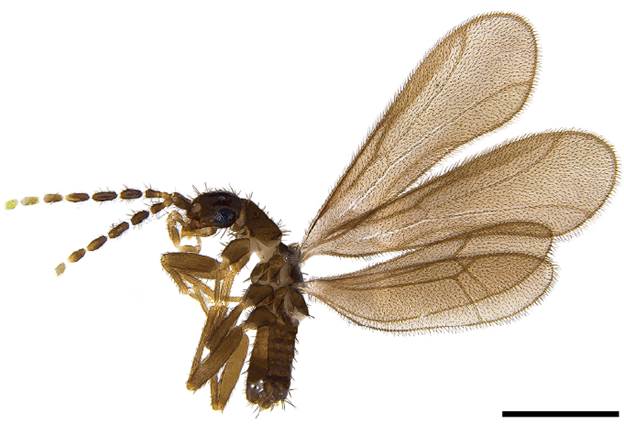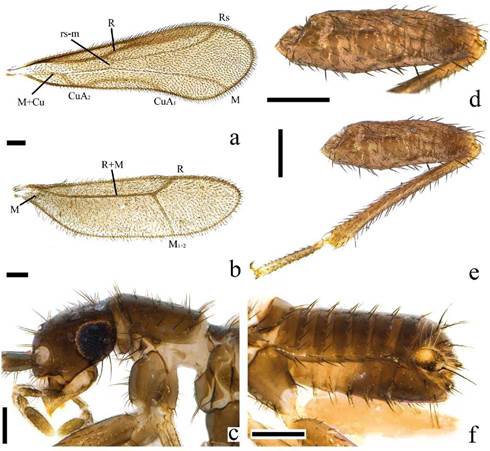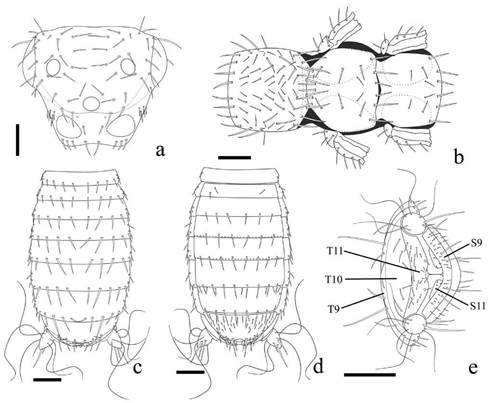INTRODUCTION
Zoraptera, also known as ground lice or angel insects, is one of the less known insect lineages in the world in terms of distribution, diversity and biology (Mashimo et al. 2014). The zorapterans are tiny insects (approximately 2-4 mm length) superficially resembling barklice (Psocoptera) or termites (Blattodea). Specimens in this order are gregarious, often living in loose colonies composed by up to 150 individuals (Engel 2009). Since the morphological description and taxonomic work carried out by Silvestri (1913), research related to Zoraptera is increasing, indicating that it is an order that has much to be discovered. Significant advances in this century are related to morphology (Beutel and Weide 2005, Friedrich and Beutel 2008, Dallai et al. 2012, 2013), paleontology (Grimaldi and Engel 2005, Engel 2008, Yin et al. 2018), taxonomy and systematics (Engel 2000, 2007, Rafael and Engel 2006, Rafael et al. 2008) and biological events such as gynandromorphism and parthenogenesis (Rafael et al. 2017).
Currently, 44 extant and 13 fossil species are known worldwide, distributed mainly in tropical and subtropical regions (Terry and Whiting 2012, Mashimo et al. 2013, 2018, Wang et al. 2016, Kocárek et al. 2017, Yin and Li 2017, Liu et al. 2018, Yin et al. 2018) including 17 occurring in the Neotropical region (Rafael et al. 2008). However, males, females, nymphs or alate morphs are unknown for most species (Rafael and Engel 2006). The knowledge about the diversity of zorapterans in Colombia is minimal, only the species Zorotypus hamiltoniNew, 1978, has been recorded based solely in a male specimen and the paratypes (alate female forms) were dealate prior capture and the wings remained unknown (Rafael and Engel 2006).
One of the main reasons why the diversity of zorapterans is poorly known in Colombia is the lack of native researchers engaged in studying these magnificent insects. Likewise, is not yet clear what collecting methods are best to be used and which environments or substrates are suitable for find them in the country (MS Engel, pers. com.). Therefore, any kind of contribution to the Zoraptera study has great value considering the current state of knowledge and how rare they are in the collections. The aim of this work is to make available for the first time a complete and detailed morphological description of an alate female of Z. hamiltoni, as a contribution to the study of Neotropical zorapterans.
MATERIALS AND METHODS
The specimen studied was preserved in 80 % alcohol following the curatorial standards of Martínez-Alava and Serna (2015). Morphological terminology follows Engel (2000), Rafael and Engel (2006) and Engel (2008). Labial and maxillary palpomeres were numbered from the base to the apex. Abdominal terga and sterna are indicated as T8, T9, S8, S9, etc., respectively. The nomenclatural terminology for wing venation follows Kukalová-Peck and Peck (1993). The term "alate" is used for individuals that are fully winged with developed compound eyes and ocelli. Measurements are given in millimeters. Body length was measured from the head, excluding antennae, to the apex of abdomen in lateral view. Fore and hind wings were measured from the anterior margin of tegula to the tip of the wing. Photomicrographs were obtained using a Leica M205A stereomicroscopic equipped with a camera and the software LAS 4© (Leica Application Suite) provided by Departamento de Biología of the Universidad Nacional de Colombia. The photographs were enhanced with Adobe Lightroom® (ver. 7.0). Illustrations of general morphology were vectorized with the free software Inkscape and Adobe Photoshop® (ver. 13.0). The specimen studied was identified using the original description of Zorotypus hamiltoni and the identification was posteriorly confirmed by Michael S. Engel of the University of Kansas, United States. The information label of the specimen studied was transcribed under the section "Material examined".
RESULTS
Material examined. A single alate female with the following data label: Colombia, Boyacá, Santa María, 4°51'52" N 73°15'40" W, 960 m, Captura en trampa Malaise, 23 dic 2016, Col. J.M. Perilla, UNAB4585. The specimen is currently housed at the Museo Entomológico. Universidad Nacional, Agronomía, Bogotá, Colombia (UNAB).
Morphology. Female (Figs. 1-3). Measurements (mm). Body length: 2.17 (excluding antennae); antennal length: 1.39; head length: 0.42; pronotum length: 0.43; pronotum width: 0.55; forewing length: 2.95; forewing width: 0.8; hind wing length: 2.27; hindwing width: 0.60: metafemoral width: 0.19; metafemoral length: 0.66; metatibial length: 0.74.

Figure 1 Alate female of Zorotypus hamiltoni, left lateral view of habitus. Last antennomere of left antenna is lacking. Scale bar = 1 mm.

Figure 2 Alate female of Zorotypus hamiltoni. a. Forewing; b. Hindwing; c. Left lateral view of head and pronotum; d. Anterior view of right metafemur; e. Anterior view of right metaleg; f. Left lateral view of abdomen. Scale bars = 0.2 mm.

Figure 3 Alate female of Zorotypus hamiltoni (appendages removed). a. Head (frontal view, antennae removed); b. Thorax (dorsal view, wings removed); c. Abdomen (dorsal view); d. Abdomen (ventral view); e. Abdominal terminalia (posterior view). Scale bars = 0.2 mm.
Integument predominantly dark brown except yellowish white (almost translucent) on the last two antennomeres, yellowish on maxillary and labial palps, light brown on legs and pale white in membranous regions (Fig. 1a).
Head (Figs. 2c, 3a). Subtriangular, slightly wider than pronotum; vertex without central, paramedian row of pronounced cluster of divergent, slender setae; compound eyes black; vertex with three ocelli; antennae with nine antennomeres: first cup-shaped, second narrow with length approximately one third of third antennomere, remaining antennomeres longer than wide, length of each similar to that of first antennomere. Head with paired setae forming longitudinal rows of four convergent setae bordering midline; distal half of labrum with long paired setae. Mandible with short rounded subapical tooth. Galea with toothed-like comb at the apex. Maxillary palpus 5-segmented, fifth palpomere two times longer than third, fourth palpomere shorter than third; second and third palpomeres with sub equal length. Labial palpus 3-segmented, third palpomere compressed dorsolaterally with similar length to the lengths of first and second palpomeres together.
Thorax (Fig. 3b). Pronotum in dorsal view subrectangular (slightly wider than long), anterior region slightly wider than posterior, predominantly flat without ridges along margins; setae long and dense mainly on anterior and posterior margins, hairs on disc shorter and scattered (Fig. 2c). Mesonotum slightly smaller than pronotum with anterior margin narrower than posterior (trapezoidal shape). Metanotum trapezoidal, wider than long with long setae on posterior margin.
Wings (Figs. 2a-b). Brown-hyaline with dense pubescence. Forewing veins M and Rs weak and nebulous; pterostigma present on anterior margin between R and Rs veins; R vein coarse, reaching the base of pterostigma and evanescent below it; Rs far away of the wing tip and it reaches the C vein close to the pterostigma; veins rs-m present, slightly longer than the abscissa of Rs; M thin, extended to posterior margin; M+Cu coarse and nebulous; CuA1 extending from posterior margin of the wing; CuA2 very short, almost absent. Hind wing with R+M, R and M1+2 veins well defined being M vein weaker; R and M1+2 fused near the antero-basal margin of wing; M short, starting near the base of the wing; Cu absent.
Legs (Figs. 1a, 2d-e). Compressed dorsolaterally with regular setae of moderate length on the dorsal surface, ventral surface almost glabrous; pro and mesofemur with regular setae, denser apically; pro and mesotibia with setae on ventral surface and two apical spines; metafemur approximately three times longer than broad, more swollen basally, posterior ventral surface with nine paired long stiff spines evenly spaced, the first five longer than the others; metatibia with two dorsal stiff spurs at the apex, slightly longer than the ventral setae.
Abdomen (Figs. 2f, 3c-e). Posterior margin of each tergum with a transverse row of long setae evenly spaced, the number of setae varies on each, noticeably more numerous on T8-T10; T10 uniformly sclerotized with a pair of setae of moderate length on posterior margin; disc with numerous short setae; T11 sclerotized, with few setae and without projections. Sterna with evenly spaced long setae (similar to tergal setae) along posterior margin, S8 and 9 with short setae on disc; posterior margin of S8 broadly rounded, not fused with S9; process on basal margin of S9 broadly spaced, with several short setae on disc and two longer hairs. Cerci conical with slightly acute apex and numerous long preapical setae; apical setae stouter than other cercal setae; preapical setae thin and long; short and dense spicules in the middle area of cerci.
Remarks
Santa María is located within the department of Boyacá between 600 m and 1200 m high. This region is characterized by periods of humid and rainy climates mainly in the months of April and October (IGAC 1977), generating suitable habitats for the establishment of zorapterans based on the observations previously made by Mashimo et al. (2014), Yin et al. (2015) and Matsumura and Njoroge (2016) where these specimens live in humid environments. Those areas are predominated by mosses, lichens in wood bark which are frequently found in the sampled locality.
Frequently these insects are captured directly or by aspirators considering their gregarious biology, however, curiously the alate female of Z. hamiltoni was captured in a Malaise trap. This capture methodology could be useful for winged zorapterans if the trap is placed in an appropriate environment. In addition, this trap reaches a greater sampling effort compared to direct capture.















